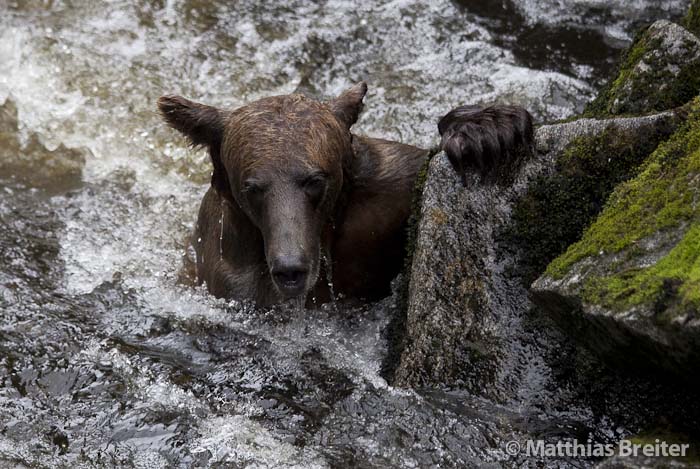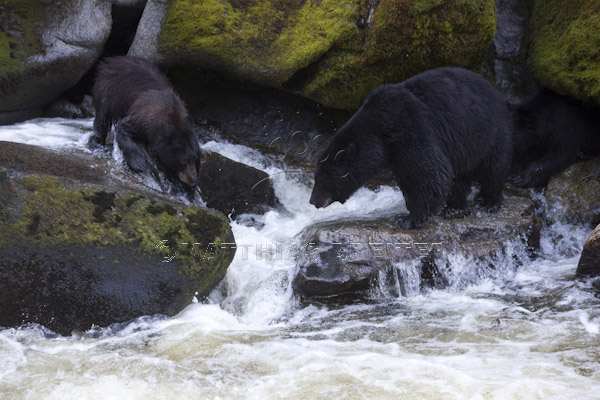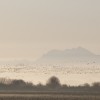 …If push comes to shove, the brown bears are dominant but mostly a fragile truce prevails. [Referring to brown bears and black bears fishing for salmon in the waters of Anan Creek south of Wrangell, Alaska] In times of overabundance, strife over a copious resource is a waste of effort. Still, black bear females, in particular females with young, usually abandon their fishing spot and leave the river or seek shelter up high in a tree when the bruins appear on the scene. Some juvenile brown bears apparently regard it as good sport to chase their smaller cousins. Mature male black bears generally stand their ground against these hooligans.
…If push comes to shove, the brown bears are dominant but mostly a fragile truce prevails. [Referring to brown bears and black bears fishing for salmon in the waters of Anan Creek south of Wrangell, Alaska] In times of overabundance, strife over a copious resource is a waste of effort. Still, black bear females, in particular females with young, usually abandon their fishing spot and leave the river or seek shelter up high in a tree when the bruins appear on the scene. Some juvenile brown bears apparently regard it as good sport to chase their smaller cousins. Mature male black bears generally stand their ground against these hooligans.

At the peak of the salmon season, between mid-July and mid-August, as many as fifteen bears can be seen fishing along the stream at the same time. Individuals who are skinny at the start of the fish run are often plump by the end of it, adding as much as two pounds of fat to their stocky frame per day. Salmon lie piled up in dense rows in the pools below small waterfalls, waiting for their turn to leap the obstacles in the river. Bears line the river, staring at the water and the promised meal contained within. Fishing techniques vary between individual bears and also between the two bear species. Some hurl themselves into the midst of schools of fish, others dive below waterfalls, again others simply stand midstream hoping for a disoriented fish to get within their reach. Generally the brown bears take a more active role in the pursuit of their prey, leaping into the stream and chasing fish into shallows. Most black bears, possibly as they feel more vulnerable, wait on the water’s edge for the opportunity to quickly grab a fish and retreat back into little caves among the boulders piled up next to the river.  Cubs learn from their mothers. Fishing techniques get passed on to the next generation and favorite fishing spots get reused by daughters and sons. Brown bear cubs sit right on the bank of the river while their mother fishes. By comparison, the offspring of a black bear female are more cautious and watch her fishing from high in a tree or sit at the base of one, always ready to scramble up the trunk to safety. The river is a dangerous place for young bears. A lack of caution, a moment of inattentiveness, can have fatal consequences. For cubs, the salmon run is a stressful, scary time of the year, a time when they have to weigh boldness against caution. Sows only feed cubs that demand a meal. A cub that is too shy, won’t get much food; one that is too courageous may not live to see the fall.
Cubs learn from their mothers. Fishing techniques get passed on to the next generation and favorite fishing spots get reused by daughters and sons. Brown bear cubs sit right on the bank of the river while their mother fishes. By comparison, the offspring of a black bear female are more cautious and watch her fishing from high in a tree or sit at the base of one, always ready to scramble up the trunk to safety. The river is a dangerous place for young bears. A lack of caution, a moment of inattentiveness, can have fatal consequences. For cubs, the salmon run is a stressful, scary time of the year, a time when they have to weigh boldness against caution. Sows only feed cubs that demand a meal. A cub that is too shy, won’t get much food; one that is too courageous may not live to see the fall.
From Matthias’s book on bears and Alaskan wildlife – Wild Alaska. View images from the book.

